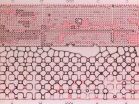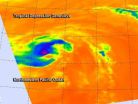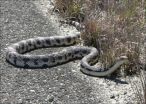(Press-News.org) All life on Earth came from one common ancestor – a single-celled organism – but what it looked like, how it lived and how it evolved into today's modern cells is a four billion year old mystery being solved by researchers at UCL using mathematical modelling.
Findings published today in PLOS Biology suggest for the first time that life's Last Universal Common Ancestor (LUCA) had a 'leaky' membrane, which helps scientists answer two of biology's biggest questions:
1. Why all cells use the same bizarre, complex mechanism to harvest energy
2. Why two types of single-celled organism that form the deepest branch on the tree of life – bacteria and archaea – have completely different cell membranes
The leakiness of the membrane allowed LUCA to be powered by energy in its surroundings, most likely vents deep on the ocean floor, whilst holding in all the other components necessary for life.
The team modelled how the membrane changed, enabling LUCA's descendants to move to new, more challenging environments and evolve into two distinct types of single-celled organism, bacteria and archaea, creating the deepest branch of the tree of life.
Bacteria and archaea share many common features such as genes, proteins and mechanisms of reading DNA, initially leading scientists to believe they were just different types of bacteria. Their classification changed in the 1970's after extreme differences were found in the way they replicate DNA and in the structure of their cell membrane. As they both stemmed from LUCA, scientists set out to find answers in the structure and function of LUCA's membrane.
Dr Nick Lane (UCL Biosciences) who led the study said, "I find this work just beautiful – it constrains a sequence of steps going from the strange cell that seems to have been the ancestor of all life today, right through to the deep division between modern cells. From a single basic idea, the model can explain the fundamental differences between bacteria and archaea. Is it right? I'd like to think so, but more importantly, it makes some clear predictions that we plan to test in the future."
Data from the study strongly suggest that LUCA lived in the area where ancient seawater, dense with positively charged particles called protons, mixed with warm alkaline vent fluid, which contained few protons. The difference in the concentration of protons across these two environments enabled protons to flow into the cell, driving the production of a molecule called adenosine triphosphate (ATP) which powered the growth of cells, just as it does today. However, unlike modern cells the scientists believe this could only happen if the membrane was 'leaky', enabling protons to leave the cell spontaneously so more protons could enter to power growth.
Dr Lane said: "In these deep sea vents, there is a continuous flow of alkaline fluids, which mix with the ocean waters. When they mix, the fluids neutralise each other, and that stops any build-up of charge which would otherwise prevent protons flowing into the cell. If the first cells had leaky membranes, then protons could enter and then be neutralised, or leave again, almost as if there was no barrier at all. What we've shown is that the rate at which protons enter and leave is high enough to power the growth of cells via proteins embedded in the membrane. So LUCA could have been powered by natural proton gradients in vents, but only if it had a really leaky membrane, completely unlike today's cells."
To escape from these seabed vents, LUCA had to adapt its membrane to pump protons out of the cell, in order for them to flow back in again to help drive ATP production. The study suggests that the bacteria and archaea developed completely different cell membrane structures and proton pumps, whilst keeping the same machinery for powering growth. It also explains why they differ in fundamental traits that depend on the membrane such as DNA replication.
Victor Sojo (UCL CoMPLEX/Biosciences), first author of the study, said: "Exploiting gradients is universal across all life, but understanding how LUCA used one to drive growth gave us a bit of a chicken-and-egg problem: LUCA wouldn't make a gradient if it didn't know how to exploit it, but how could it learn how to exploit a gradient if it didn't make one in the first place? We propose that natural proton gradients provide a solution because LUCA didn't have to make the gradient; it was already there for free. We show that modern 'non-leaky' membranes had to evolve later, and they did so independently in archaea and bacteria. This explains why membrane bioenergetics are universal in archaea and bacteria yet ion pumps and membranes are different, which has been the big unknown."
For their next project, Dr Lane and his team hope to recreate the environment of the vents, which are believed to have been where the building blocks of life spontaneously formed four billion years ago, to gain further insight into how molecules behave and interact in such conditions.
INFORMATION:
Our ancestor's 'leaky' membrane answers big questions in biology
2014-08-12
ELSE PRESS RELEASES FROM THIS DATE:
Overhaul of our understanding of why autism potentially occurs
2014-08-12
MONTREAL, August 12, 2014 – An analysis of autism research covering genetics, brain imaging, and cognition led by Laurent Mottron of the University of Montreal has overhauled our understanding of why autism potentially occurs, develops and results in a diversity of symptoms. The team of senior academics involved in the project calls it the "Trigger-Threshold-Target'' model. Brain plasticity refers to the brain's ability to respond and remodel itself, and this model is based on the idea that autism is a genetically induced plastic reaction. The trigger is multiple brain ...
Foam favorable for oil extraction
2014-08-12
HOUSTON – (Aug. 12, 2014) – A Rice University laboratory has provided proof that foam may be the right stuff to maximize enhanced oil recovery (EOR).
In tests, foam pumped into an experimental rig that mimicked the flow paths deep underground proved better at removing oil from formations with low permeability than common techniques involving water, gas, surfactants or combinations of the three.
The open-access paper led by Rice scientists Sibani Lisa Biswal and George Hirasaki was published online today by the Royal Society of Chemistry journal Lab on a Chip.
Oil ...
Decline in daily functioning related to decreased brain activity in Alzheimer's
2014-08-12
Boston, MA – Decline in daily functioning associated with Alzheimer's disease is related to alterations in activity in certain regions of the brain, according to a study published in the August 2014 issue of the Journal of Alzheimer's Disease.
Impairment in instrumental activities of daily living—or an inability to perform high-level daily activities such as calculating finances, remembering appointments and medications, and driving—is first seen when a person has mild cognitive impairment, which can later progress to dementia due to Alzheimer's disease. Deterioration ...
Immigrants at lower risk of overdose, death from codeine than people born in Canada
2014-08-12
TORONTO, Aug. 12, 2014—Immigrants are at lower risk of an overdose or death after being prescribed codeine than people born in Canada, a new study has found.
Surprisingly, this is true even when the immigrants lack proficiency in English or French, which might be thought to hamper their ability to read prescription labels or instructions, said lead author Dr. Joel Ray, a physician and researcher at St. Michael's Hospital.
His study was published in the current issue of the Journal of Epidemiology and Community Health.
Dr. Ray undertook this study because of the large ...
Beating childhood cancer does not make survivors healthier adults
2014-08-12
Having survived cancer as a child does not necessarily have a ripple effect that makes people lead a healthier lifestyle once they grow up. In fact, in a report derived from a National Cancer Institute-funded study of childhood cancer survivors known as the Chicago Healthy Living Study, investigators found that childhood cancer survivors in no way adhere more closely to guidelines on healthy eating than their cancer-free peers. The findings are published in Springer's Journal of Cancer Survivorship.
Childhood cancer survivors face different health-care challenges and ...
Contrary to popular belief, more exercise is not always better
2014-08-12
Rochester, MN, August 12, 2014 – There is strong epidemiological evidence of the importance of regular physical activity, such as brisk walking and jogging, in the management and rehabilitation of cardiovascular disease and in lowering the risk of death from other diseases such as hypertension, stroke, and type 2 diabetes. The Physical Activity Guidelines for Americans recommends about 150 minutes per week of moderate-intensity exercise or about 75 minutes of vigorous-intensity exercise. But there is clear evidence of an increase in cardiovascular deaths in heart attack ...
Climate relicts may help researchers understand climate change
2014-08-12
While hiking through the Ozarks' characteristic oak and hickory forests as a teenager, ecologist Scott Woolbright discovered something decidedly uncharacteristic for the region: prickly pear cacti growing on an exposed, rocky ledge.
In a recent paper published in Trends in Ecology and Evolution, Woolbright describes how populations and communities like these, known as climate relicts, can help scientists understand how ecological communities are affected by climate change.
Rocky, well-drained slopes in the Ozarks often create habitat "islands" within the surrounding ...
NASA sees the end of Tropical Depression Genevieve
2014-08-12
Cloud tops were warming and precipitation was waning in Tropical Depression Genevieve when NASA's Aqua satellite flew overhead. Genevieve moved through all three Pacific Ocean regions (eastern, central and western) in its two week lifetime and met its end today.
NASA's Aqua satellite passed over Tropical Depression Genevieve on Aug. 11 at 01:29 UTC and the Atmospheric Infrared Sounder (AIRS) captured infrared data on the storm. AIRS data showed a small area of the strongest thunderstorms were occurring over the northern quadrant, where temperatures approached -63F/-52C. ...
Roadside research from the pinelands and coast to coast
2014-08-12
PHILADELPHIA (August 12, 2014)— "Roads are essentially the primary feature of human civilization at this point," according to Dane Ward, a doctoral student in environmental science at Drexel University who is presenting research at the Ecological Society of America (ESA) meeting.
Perhaps not surprisingly, Ward, along with fellow doctoral students Ryan Rebozo and Kevin P.W. Smith from the Laboratory of Pinelands Research led by Walter Bien, PhD in Drexel's College of Arts and Sciences, took advantage of a cross-country roadtrip from Philadelphia to the meeting in Sacramento ...
UMN and NYBC research finds potential MERS transmission mechanism between bats and humans
2014-08-12
Researchers have identified the mechanism used by the deadly MERS virus to transmit from bats to humans. Bats are a native reservoir for MERS and the finding could be critical for understanding the animal origins of the virus, as well as preventing and controlling the spread of MERS and related viruses in humans.
The findings were published in the most recent edition of the Proceedings of the National Academy of Sciences.
Leading the research was Fang Li, Ph.D., associate professor of Pharmacology at the University of Minnesota Medical School. Graduate students Yang ...





